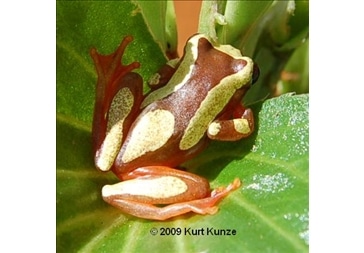Description:
Being true treefrogs, up is good. You can house two frogs in something as small as a 10-gallon tank, but the taller the tank, the better. Add 5 gallons of space for each frog you plan to house together. Start with a base of coconut core a couple inches deep. Spread some orchid moss over the top. Place a nice-sized water bowl in the tank, or get creative and set up a waterfall, which can be purchased complete or make your own. There are waterfall kits available at specialty reptile stores. Naturalistic, front-opening enclosures are great for these frogs. Add branches to the enclosure and lots of plants. Real plants are great, but if you don’t have a green thumb, just use a lot of natural-looking fake plants on the market today. The denser the plants and branches, the more the frogs will like it. A couple of hides on the ground are also welcome and might be used every so often. These frogs are tropical, so a daily misting to maintain a humidity of about 75 to 80 percent is needed. You can also use one of the automatic reptile misters on the market. No light is needed, and for the most part, room temperatures are fine for them. Try to keep the temps between 70 and 80 degrees Fahrenheit. These little guys are insectivores. They will eat a wide range of insects, including crickets, mealworms, roaches and other small bugs. Either gut-load or apply calcium and multivitamin supplements to the insects. Presenting the feeders in a slick-sided glass bowl works well to keep the bugs in one place, and this way, the frogs know where to find their food, too. Clown tree frogs come in a variety of colors and patterns. These beautiful frogs are common throughout their range and live close to human habitation in parts of their range, making them easy to find and frequently captured for the pet trade. Most clown tree frogs are field-collected imports. Captive breeding in the United States is starting to pick up steam, and as always, captive-bred animals are better all the way around. But until more captive breeding takes place, most all of these amazing frogs are still coming from the wild. Beautiful, colorful and pretty easy to keep if kept at the right humidity levels, this is an ideal terrarium subject. A great beginner frog for people who want to explore amphibian keeping. Ken Foose produced his first captive-bred snakes at age 11. With a Master’s Degree in zoology, he has been both a zookeeper and curator. He opened Exotic Pets, which specializes in reptiles and amphibians, in Las Vegas in 1991. He is currently president of the International Herpetological Symposium.
Habitat:
Lowland Rainforests and humid jungles. Near water.
Range:
Throughout Central and South America
Scientific Name: Dendropsophus leucophyllatus
Species Group: frog
Family: Hylidae
Size: 1 to 2 inches
Level: intermediate
Weight: N/A
Dangerous: No


